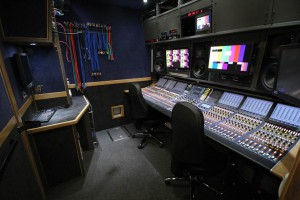Lawo in play for Commonweath Games’ table tennis broadcasts
The broadcast of the table tennis matches at Scotstoun Arena, Glasgow, during the 2014 Commonwealth Games was handled by Arena Television, with audio guarantee engineer David Harnett taking charge of the company’s OB14 mobile – and its Lawo digital mixing and routing systems.
Harnett joined Arena TV around three years ago having previously worked on Lawo consoles, which he regards as “very intuitive”. OB14, meanwhile, has come to sports broadcasting from use on Arena TV’s music events.
The Lawo console in OB14 was used as a hub to provide central routing for both of the ‘show’ tables – dubbed Table Tennis 1 and Table Tennis 2 – with one DSP core used as central router for both. Specifically, there was a 56-fader Lawo mc266 MkII console serving Table 1, with a Studer Vista digital console hooked up as a submixer to cover the action on Table 2 – both tables being in use simultaneously and requiring their own audio feeds.
Although the players were not as mobile as track athletes and the ball was not tracked in the way of other court sports, extensive miking of the tables called for a surprisingly high number of console channels.
As the tables were adjacent, the same four microphones provided crown noise. Each table then used four further mics as ‘near’ and ‘far’ left-right pairs, with two electret condensers on the nets and a pair of near-far shotgun mics to pick up foot squeaks. In addition, there were mics on the umpire and coaches for each match, giving a total of 10 mics on each table.
“In preparation, we had to set all the signal paths in and out of both tables to go through the Lawo, because of the large amount of MADI and I/O required. We basically made the Vista a slave on a MADI stream, so all the brunt of the work was being done by the Lawo,” Harnett explains.
He emphasises the importance of the “large amount of I/O and lots of MADI streams” that were required to be available in order to support the use of the second console. “We also used different banks and layers to be able to have Table 2 at our fingertips if needed. It was also from this bank that we controlled all the mic amps being used for Table Two,” he says. “We used EQ recall and save for quick commentator turnarounds. In addition, the Lawo’s multi-row metering was very useful, as we had a lot of outgoing lines and feeds and to be able to see these on a second metering row made life a lot easier for us. Lastly, the snapshot function was essential in getting the desk into different modes of mixing quickly for changes of operator.”
Taking a more general look at Lawo systems from a broadcast sound operator’s point of view, Harnett underlines the value of being able to configure them to meet a wide range of requirements. “They are extremely flexible, and this is useful for jobs that need to work outside of the box a little,” he confirms.


